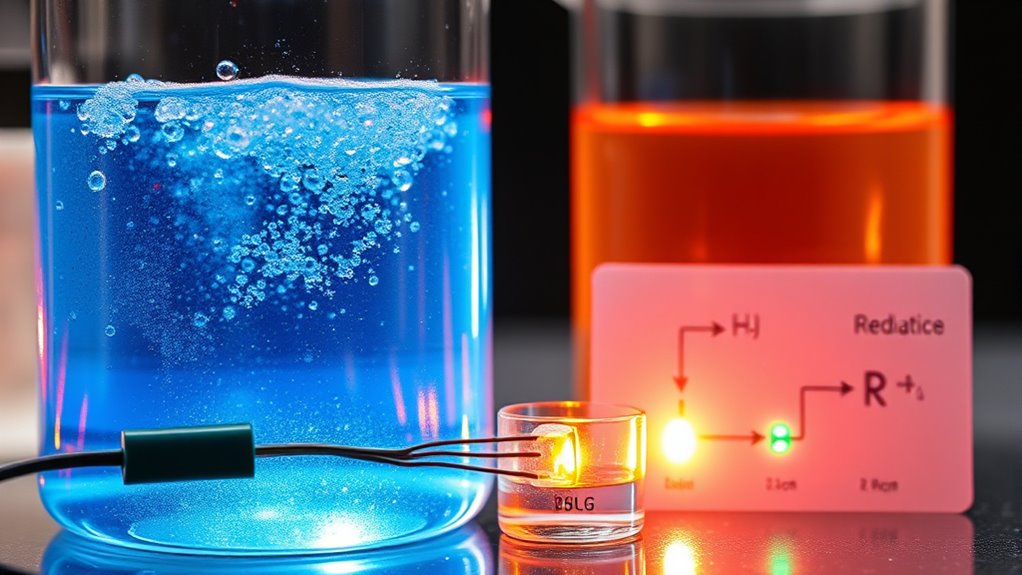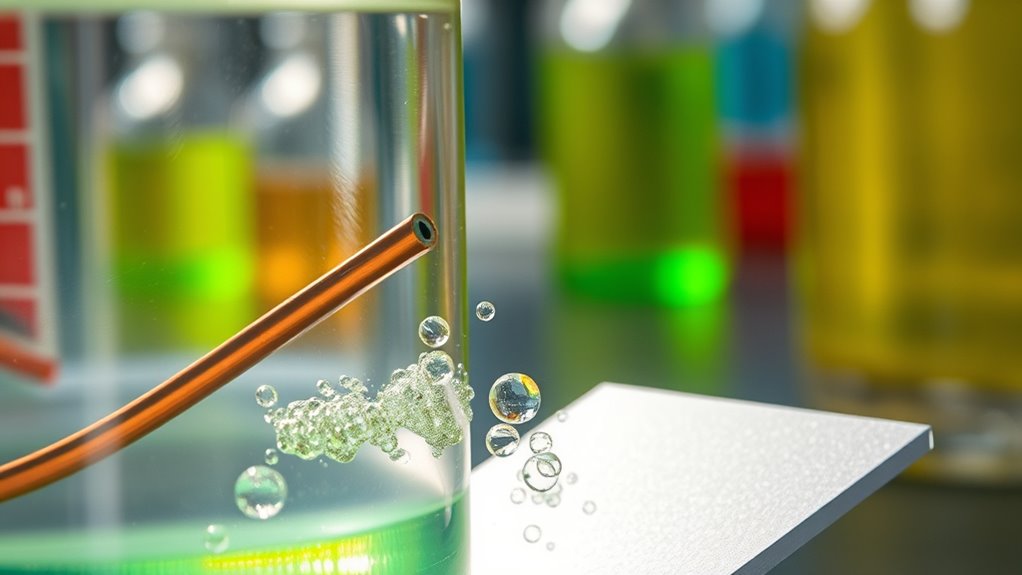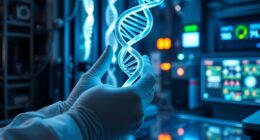Redox reactions happen when electrons move between molecules, atoms, or ions. Oxidation means losing electrons, while reduction means gaining them. You can track these changes using oxidation numbers, which help identify which substances are oxidized or reduced. These reactions are everywhere, from how your body makes energy to how rust forms. Understanding the roles of oxidizing and reducing agents can help you see these processes in action—and there’s more to discover if you keep exploring.
Key Takeaways
- Redox reactions involve electron transfer where oxidation is loss and reduction is gain of electrons.
- Oxidation increases an element’s oxidation number; reduction decreases it.
- Oxidizing agents accept electrons, while reducing agents donate electrons.
- Tracking oxidation numbers helps identify which species is oxidized or reduced.
- Balancing redox equations involves separating into half-reactions, then matching electrons transferred.
Understanding Oxidation and Reduction

Have you ever wondered what really happens during a redox reaction? It all comes down to electrons. Oxidation happens when a molecule, atom, or ion loses electrons, while reduction occurs when another gains those electrons. These processes happen simultaneously, so one species gets oxidized, and another gets reduced—this is the essence of redox reactions.
The key change is in the oxidation number, which increases during oxidation and decreases during reduction. Historically, oxidation involved adding oxygen or removing hydrogen, but today, it’s understood as electron transfer. The transfer of electrons is central to redox processes, and tracking these changes helps identify which species are oxidized or reduced. Understanding oxidation and reduction provides insight into many chemical and biological processes beyond basic reactions.
Oxidizing agents accept electrons and become reduced, while reducing agents donate electrons and become oxidized. This exchange drives many crucial processes, from cellular respiration to corrosion, making redox reactions fundamental to life and industry.
Recognizing Redox Reactions in Daily Life

Redox reactions are all around us, shaping many daily activities and household processes. You see them in biological functions like cellular respiration, where glucose is oxidized to produce energy, and in photosynthesis, where plants reduce carbon dioxide to make food. The process of electron transfer in redox reactions is fundamental to energy production in living organisms. When you use cleaning agents like bleach, redox reactions break down stains and kill germs. Cooking involves oxidation reactions, such as browning and caramelization, changing flavors and colors. Rusting of iron occurs when metal reacts with moisture and oxygen, causing deterioration. Even in energy storage, batteries rely on redox reactions to generate electricity. Recognizing these reactions helps you understand how everyday products, processes, and natural phenomena depend on electron transfer, making redox chemistry a fundamental part of daily life. Understanding electron transfer is essential for grasping how various technologies and biological systems function seamlessly.
The Role of Oxidizing and Reducing Agents

Oxidizing and reducing agents play crucial roles in chemical reactions by driving electron transfer processes. When an oxidizing agent gains electrons, it causes another species to oxidize, becoming reduced itself.
Conversely, a reducing agent donates electrons, causing another species to reduce and itself to oxidize. These agents always come in pairs, each fueling the other’s transformation.
The species gaining electrons acts as the oxidizing agent, while the one losing electrons is the reducing agent. For example, in the reaction ( ce{MnO4^- + SO3^{2-}} ), (ce{MnO4^-}) is the oxidizing agent, and (ce{SO3^{2-}}) is the reducing agent.
Recognizing these agents helps you understand how electrons are transferred, driving chemical changes essential in both industrial processes and biological systems. Inspirational quotes about fatherhood can remind us of the importance of guidance and support, much like these agents facilitate change in chemical reactions.
Tracking Electron Transfer With Oxidation Numbers

Tracking electron transfer in chemical reactions becomes clearer when you use oxidation numbers. These numbers act as a bookkeeping tool, representing the hypothetical charge each atom would have if all bonds were ionic. Automation in industries has led to the development of more sophisticated methods for analyzing chemical processes, including redox reactions. By comparing oxidation numbers in reactants and products, you can identify which species is oxidized (loses electrons) and which is reduced (gains electrons). Each change of one in oxidation number corresponds to the transfer of one electron. Monitoring these shifts helps you visualize electron flow and understand redox processes. Remember, oxidation involves an increase in oxidation number, while reduction involves a decrease. Ensuring that overall changes balance is essential. Using oxidation numbers simplifies tracking electron transfer, especially in complex reactions, making redox processes much easier to analyze.
Balancing Redox Equations Effectively

Balancing redox equations accurately is essential for understanding how electrons transfer between reactants and products. To do this, start by separating the reaction into oxidation and reduction half-reactions. A thorough understanding of the oxidation and reduction processes helps in correctly identifying which species are gaining or losing electrons. Balance each half-reaction for atoms, then add H₂O to balance oxygen and H⁺ for hydrogen in acidic solutions. Next, balance the charge by adding electrons to the appropriate side. Afterward, equalize the number of electrons transferred in both half-reactions by adjusting coefficients. Combine the half-reactions, ensuring that electrons cancel out. Always verify that both mass and charge are balanced before finalizing. In basic conditions, add OH⁻ ions instead of H⁺. Using this step-by-step approach guarantees precise balancing, helping you understand electron flow and the overall redox process effectively.
Applications of Redox Reactions in Technology

Redox reactions play an essential role in advancing modern technology, particularly in energy production and storage systems. In fuel cells, redox reactions generate electricity cleanly, reducing dependence on fossil fuels. Maximizing efficiency techniques in redox processes continue to evolve, further enhancing energy solutions. Batteries like lithium-ion and redox flow batteries are critical for efficient energy storage, supporting renewable sources. The hydrogen economy relies on redox reactions to convert hydrogen into usable energy in fuel cells, offering a sustainable alternative. Advances in materials, including organic electrodes, aim to boost recyclability and reduce rare metal use. Redox processes also improve environmental tech, enabling water treatment, pollution control, and nanotechnology integration. These reactions drive innovation across industries, making energy systems cleaner, more efficient, and sustainable, shaping the future of technology and environmental conservation.
Frequently Asked Questions
How Do Redox Reactions Influence Biological Systems Beyond Metabolism?
Redox reactions impact biological systems in many ways beyond metabolism. You see, they regulate neurotransmitter release, influence neural development, and shape aging processes.
They also control immune responses, activate signaling pathways, and modulate ion channel functions. By managing oxidative stress and redox balance, you help maintain cellular health, prevent neurodegeneration, and guarantee proper brain function.
This highlights the essential role redox reactions play throughout your body’s complex biological systems.
What Are Common Signs Indicating a Redox Reaction Is Occurring?
When you observe subtle shifts in color, heat release, or physical changes, you’re likely witnessing a redox reaction in action. These signs indicate atoms are exchanging electrons, with some gaining and others losing them.
Look for metals rusting, sparks in combustion, or solutions changing hue. Such visual cues and energy changes are gentle hints that oxidation and reduction are quietly at work, transforming substances in fascinating ways.
How Do Redox Reactions Impact Environmental Pollution Control?
You see redox reactions play a crucial role in controlling environmental pollution. They help microbes break down harmful pollutants in soil and water, making environments safer.
In water treatment, redox reactions generate reactive species that degrade contaminants. They also transform pollutants in air emissions into less toxic substances, reducing smog and acid rain.
Can Redox Reactions Be Reversed or Controlled?
Think of redox reactions as a dance—you can change the steps by shifting conditions or applying an external nudge. You control this choreography with factors like potential, pH, and catalysts. By adjusting these elements, you can reverse or steer the reaction’s direction.
Enzymes and electrochemical methods act as your dance partners, helping you keep the rhythm and balance, ensuring the reactions move precisely as you intend.
What Role Do Catalysts Play in Accelerating Redox Processes?
You might wonder how redox processes speed up, and catalysts play a key role. They lower activation energy, making electron transfer easier, even at milder potentials.
Catalysts cycle between forms without being consumed, increasing the local concentration of charged intermediates. This boosts reaction rates and enhances selectivity, whether in biological systems, photocatalytic processes, or environmental applications.
Fundamentally, catalysts make redox reactions faster, more efficient, and more controllable.
Conclusion
Now that you’ve uncovered the secrets behind redox reactions, imagine all the unseen changes happening around you every day. From batteries to biological processes, these reactions power and sustain life in ways you never realized. But there’s still more to explore—what other surprises do redox reactions hold? Stay curious, because the world of oxidation and reduction is full of mysteries waiting to be revealed. Are you ready to dive deeper into this fascinating world?









